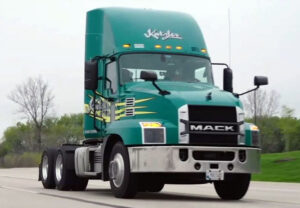Jason Douglass of Stokes Trucking knows the importance of driver retention.
The 36-year-old, who serves as director of recruiting and retention for Tremonton, Utah-based Stokes Trucking, began his career in the industry as a driver for a plumbing company before moving into warehouse management and dispatch, sales, safety management, and, finally, recruiting.
Because he’s actively worked in so many facets of the industry, Douglass has first-hand knowledge of many of the challenges faced by employees. As a trucking executive, he also knows that many motor carriers are struggling to retain drivers and experiencing high turnover rates.
While finding qualified drivers is vital, Douglass says the “retention” portion of his title is the main focus at Stokes — and that’s exactly the way he likes it.
“Our turnover is super-low,” he told Truckload Authority. “Anybody can bring drivers in. The importance of my role is to keep people with the company.”
When he was recruited by Stokes in 2022, he was impressed by the company’s culture and the mindset of working to retain valued employees.
“Our cultures matched,” Douglass said. “Stokes’ culture is clear on its social media pages. It’s like we instantly clicked.”
Currently the company, which specializes in transporting refrigerated foods, employs 55 drivers and operates 50 trucks and 112 refrigerated trailers — and it is working to expand. Drivers average 2,800-3,200 miles a week, with routes designed to allow drivers to enjoy home time weekly.
Of course, he says, driver retention begins with smart recruiting and hiring.
“If you recruit the right people, you don’t have to recruit as much,” he explained, adding that he’d rather have an empty truck than hire the wrong person to drive it.
So, one might ask, how can recruiters make sure they find the right people? While there’s not a one-size-fits-all answer, Douglass shared his basic strategy.
When interviewing prospective drivers, he says, the first few questions are friendly “get to know you” queries. Once he knows a little about the driver’s personality and goals, he says, he works to find out exactly what the driver is looking for in a company. Next, he asks about previous employers.
In some cases, he says, a previous company’s culture simply wasn’t a good fit for a specific driver (or vice versa).
“There are some people, some companies that I know are just bad fits,” he said. “Then there are companies I know have the same hiring criteria as us.”
In short, he says, the initial interview needs to go far beyond the driver’s skills and qualifications.
“Between those questions, I can pick up red flags. For instance, a recruit might ask if we do hair follicle drug testing,” he explained. “If they wince, that’s probably the biggest red flag I see.
“I start asking qualifying questions,” he continued. “I get them to talk, and I get a feeling for their personalities. We’re not a fit for everybody — and everybody is not a fit for us.”
In addition, Douglass says, he looks at the way a driver has quit previous jobs.
“We won’t hire anybody unless they put in two weeks’ notice with their current company,” he said. “We don’t want anyone to do that to us.”
When it comes right down to it, the question isn’t whether the driver wants to work for Stokes; it’s a question of whether the company wants to hire a particular driver.
“We don’t just put butts in seats, so I ask questions,” he said. “Our motto is, ‘Do the right thing,’”
That motto goes both ways. “What’s the right thing to you? What are your morals?” he said. “There’s no ‘secret sauce’ in our success. It’s just being genuine.”
As noted earlier, Stokes has a low turnover rate (10% to 14%). More often a driver is let go rather than quitting, Douglass said.
“We probably terminate more than quit because we have a high safety standard,” he explained. “You must have a high standard in this day and age. You’re always trying to protect assets.”
Of course, a driver’s experience and safety record are also important, and Douglass says the recruiting team works closely with the company’s safety director.
“We both know what we’re looking for in a good driver — and we know what the company’s looking for,” he said. “We won’t hire anybody without all of us meeting them.”
Once the team is sure they’ve found a driver who’s a good fit for the company, the “real” work — retention — begins.
At Stokes, Douglass says, the culture is designed to ensure the group works together as a team, with a common goal. Of course, pay is important, but there are other factors that result in loyal, happy employees.
“Drivers’ checks don’t fluctuate more than 10% weekly, and we have some drivers that make up to $100,000 a year,” he said, adding that consistency in freight and miles goes a long way toward ensuring satisfied drivers.
“In this market, drivers can work anywhere. So, especially for younger drivers, a carrier needs to be a place they WANT to work,” he said.
Breaking down traditional business barriers is another key to success.
“At so many companies, there’s a hierarchy,” Douglass said. “Drivers are at the bottom, and then there’s office employees. You must eliminate the hierarchy.”
This involves making sure drivers have a voice in the company. In addition, he says, drivers appreciate a friendly environment and decent facilities.
“You can’t make it like drivers are separated from the office,” Douglass said. “At many companies, management SAYS they have an open-door policy … but do they really mean it? Our owner sits with the dispatcher.
“I’m very approachable. I want people to bring up concerns,” he continued. “However, it doesn’t do any good if there’s no action. I am proactive about what people bring me, and I follow up. Once that reputation is set, the job is easier. People depend on me.”
While the goal of any business is to see a profit, the best companies are often known for having the “human touch.”
“You have to have empathy in recruiting and retention,” Douglass shared. “Without it, you’re not of much use. You need to be able to put yourself in the potential employee’s position. Some people say, ‘Just tough it up and drive.’ Well, we’re not in that market anymore. We realize that good drivers can go work somewhere else.”
Photo by Linda Garner-Bunch/Truckload Authority
This article originally appeared in the May/June 2024 edition of Truckload Authority, the official publication of the Truckload Carriers Association.
Since retiring from a career as an outdoor recreation professional from the State of Arkansas, Kris Rutherford has worked as a freelance writer and, with his wife, owns and publishes a small Northeast Texas newspaper, The Roxton Progress. Kris has worked as a ghostwriter and editor and has authored seven books of his own. He became interested in the trucking industry as a child in the 1970s when his family traveled the interstates twice a year between their home in Maine and their native Texas. He has been a classic country music enthusiast since the age of nine when he developed a special interest in trucking songs.







